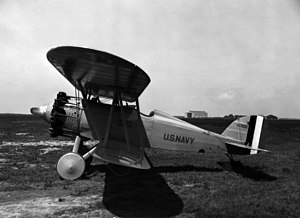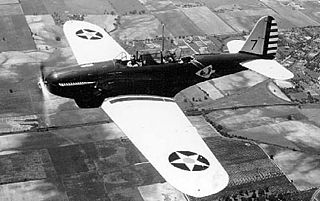| XF3W | |
|---|---|
 | |
| Wright XF3W Apache | |
| Role | Racer |
| National origin | United States |
| Manufacturer | Wright Aeronautical |
| First flight | 5 May 1926 [1] |
| Number built | 1 |
The Wright XF3W was an American racing aircraft built by Wright Aeronautical for the United States Navy.
| XF3W | |
|---|---|
 | |
| Wright XF3W Apache | |
| Role | Racer |
| National origin | United States |
| Manufacturer | Wright Aeronautical |
| First flight | 5 May 1926 [1] |
| Number built | 1 |
The Wright XF3W was an American racing aircraft built by Wright Aeronautical for the United States Navy.
After the U.S. Navy declared its preference for radial engines, Wright developed the P-1 Simoon. To demonstrate the engine, the F3W was designed to carry it. The F3W was a single-seat biplane, with a steel tubing fuselage and wood wings, covered by fabric. Designed to be a carrier-based fighter and powered by the Simoon engine, its performance was poor. After the Navy took delivery of the aircraft, they installed a rival company's engine, the Pratt & Whitney R-1340 radial. The aircraft was redesignated XF3W, and flew with the new engine for the first time on 5 May 1926. [1]
The Navy used the XF3W as a test bed for the Pratt & Whitney engine until 1930, during which time the aircraft set a number of records. On 6 September 1929, the XF3W piloted by Apollo Soucek set the world altitude record for seaplanes of 38,500 ft (11,700 m); on 6 April 1930, Soucek set the landplane altitude record of 43,166 ft (13,157 m). [1] The XF3W was also fitted with a single centreline float to evaluate the concept of basing floatplanes on battleships. [2]

Data from Angelucci, 1987. p. 462. [1]
General characteristics
Performance

The Douglas Dolphin is an American amphibious flying boat. While only 58 were built, they served a wide variety of roles including private air yacht, airliner, military transport, and search and rescue.

The Curtiss XF14C was an American naval fighter aircraft. It was developed by Curtiss-Wright in response to a request by the United States Navy in 1941 to produce a new shipboard high-performance fighter aircraft.

The Vought XF3U was the prototype of a two-seat, all-metal biplane fighter, built by Vought Aircraft Company of Dallas, Texas for the United States Navy.

The Vought SBU-1 Corsair was a two-seat, all-metal biplane dive bomber built by Vought Aircraft Company of Dallas, Texas for the US Navy. Its design was based upon the F3U-1 two-seat fighter that was abandoned when the Navy decided not to obtain any more two-seat fighters.

The Consolidated P-30 (PB-2) was a 1930s United States two-seat fighter aircraft. An attack version called the A-11 was also built, along with two Y1P-25 prototypes and YP-27, Y1P-28, and XP-33 proposals. The P-30 is significant for being the first fighter in United States Army Air Corps service to have retractable landing gear, an enclosed and heated cockpit for the pilot, and an exhaust-driven turbo-supercharger for altitude operation.

The General Aviation XFA was an American biplane fighter aircraft built by the General Aviation Company for the United States Navy.

The Berliner-Joyce XFJ was a United States prototype biplane fighter aircraft that first flew in May 1930. Designed by Berliner-Joyce Aircraft for the United States Navy, its lower wing, placed below the fuselage and just two feet above the ground, apparently gave it a tendency to ground loop when landing, and it was never ordered for production.

The Boeing F2B was a biplane fighter aircraft of the United States Navy in the 1920s, familiar to aviation enthusiasts of the era as the craft of the Three Sea Hawks aerobatic flying team, famous for its tied-together formation flying.

The Boeing XF6B-1 / XBFB-1 was Boeing's last biplane design for the United States Navy. Only the one prototype, Model 236, was ever built; although first flying in early 1933, it rammed into a crash barrier in 1936 and the design was not pursued further.

The Curtiss F6C Hawk was a late 1920s American naval biplane fighter aircraft. It was part of the long line of Curtiss Hawk airplanes built by the Curtiss Aeroplane and Motor Company for the American military.

The Curtiss F7C Seahawk was a carrier-capable biplane fighter aircraft of the United States Navy Marine Corps in the late 1920s and early 1930s.

The Vought XF2U was a prototype biplane fighter aircraft evaluated by the United States Navy at the end of the 1920s, but was already outclassed by competing designs and never put into production.

The Boeing XP-15 was an American prototype monoplane fighter.

The Boeing P-29 and XF7B-1 were an attempt to produce a more advanced version of the highly successful P-26. Although slight gains were made in performance, the U.S. Army Air Corps and U.S. Navy did not order the aircraft.

The Eberhart XFG was an American single-seat experimental ship-borne biplane fighter aircraft developed for the United States Navy in 1927 by the Eberhart Aeroplane and Motor Company. The sole prototype was rebuilt into the XF2G with the addition of a single float and a different engine, but the aircraft was destroyed in a crash in 1928, and the type did not enter production.

The Berliner-Joyce XF3J was an American biplane fighter, built by Berliner-Joyce Aircraft. It was submitted to the United States Navy for their request for a single-seat carrier-based fighter powered by a 625 hp (466 kW) Wright R-1510-26 engine.

The Douglas XFD was a carrier-based biplane fighter aircraft designed for the United States Navy, and the first fighter to be built by the Douglas Aircraft Company. A victim of changing requirements, no production was undertaken.

The Northrop XFT was an American prototype fighter aircraft of the 1930s. A single engined low-winged monoplane, it was designed and built to meet a United States Navy order for an advanced carrier based fighter. It exhibited poor handling, and was rejected by the Navy, the single prototype being lost in a crash. A variant, the Northrop 3A, also was unsuccessful.

The Vought V-141 was a prototype American single-seat fighter aircraft of the 1930s. It was a development of the unsuccessful Northrop 3-A design, but was itself a failure, being rejected by the United States Army Air Corps. The sole prototype was sold to the Japanese Army in 1937, but no production followed, with the type proving to be inferior to existing Japanese fighters.

The Berliner-Joyce XF2J was the company's second biplane fighter for the United States Navy. The XF2J was ordered on 30 June 1931 and although designated as a two-seat fighter, it was used as an observation aircraft.
![]() Media related to Wright XF3W Apache at Wikimedia Commons
Media related to Wright XF3W Apache at Wikimedia Commons